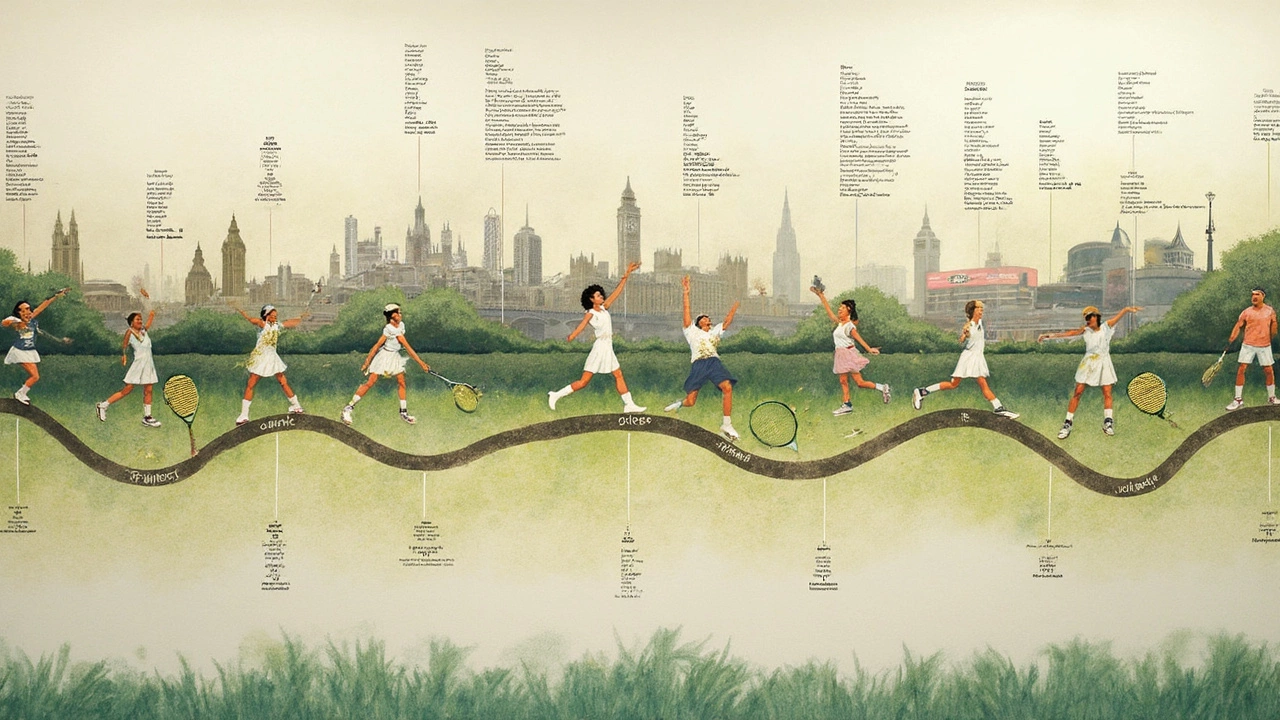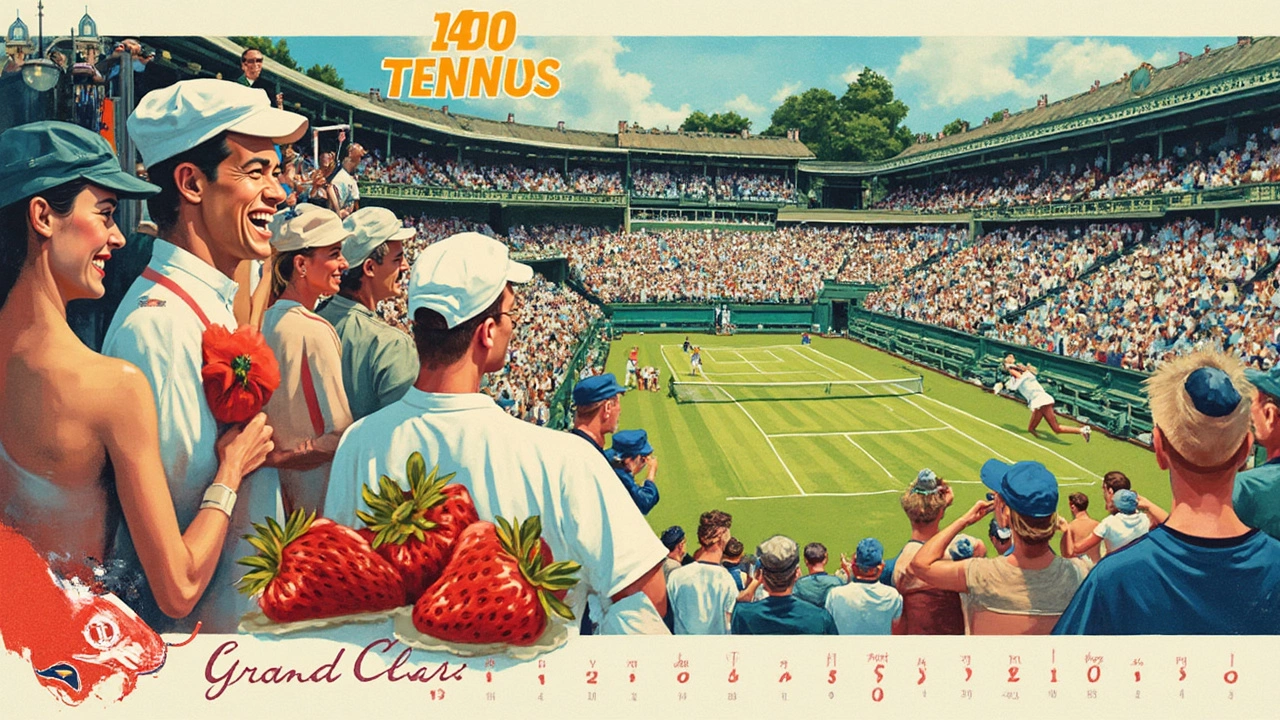If you’ve ever looked at the tennis calendar and thought, “Why does Wimbledon always seem to pop up in the middle of summer?”—you’re not alone. The tennis season has a strict order, and knowing it helps fans catch their favorite players at the right moments. The year isn’t just a random jumble of events; there’s a rhythm to which big tournaments fall when, and how players plan their schedules around them.
For starters, the pro tennis season begins in January. That’s when players shake off any holiday rust and hit the courts. The first major stop? The Australian Open. But between each Grand Slam, there’s a whole lineup of smaller tournaments that spice things up and let new names shine. This order isn’t just tradition—it affects how players pace themselves and how fans can plan for the showdowns no one wants to miss.
- How the Tennis Year Kicks Off
- The Four Grand Slams and Their Place
- Smaller Tournaments That Matter
- Tennis Calendar Highlights: Surprises and Traditions
- Tips for Following the Tournament Order
How the Tennis Year Kicks Off
The tennis tournaments season doesn’t wait around. Once January rolls in, the action starts right away, mostly Down Under in Australia. The first big taste of what’s to come is the Australian Open, always landing in mid to late January. It’s the first Grand Slam of the year and sets the vibe for the rest of the season.
Players don’t just jump into the Australian Open cold, though. Leading up to it, you’ll spot a bunch of warm-up tournaments, like the Brisbane International and the Adelaide International. There’s also the United Cup—a newer mixed-gender event where countries battle it out as teams. These events matter because they give players match practice and let them adjust to the Aussie summer heat (trust me, it gets intense out there).
Here’s a quick look at how January usually shapes up on the tennis calendar:
- First two weeks: Smaller tournaments in Australia and New Zealand, plus the United Cup.
- Mid-to-late January: The Australian Open—the first Grand Slam of the year.
Fun fact: Because of Australia’s time zone, matches often finish when it’s the middle of the night in Europe or the US. A few classic showdowns have even ended after 2 a.m. local time!
If you’re planning to catch the early-season action, grab some coffee—those match times can be wild. For pro players, a strong start in Australia can shape their whole season: momentum, ranking points, even confidence. That’s why no one treats January’s tournaments like a warm-up, especially with so much at stake.
The Four Grand Slams and Their Place
When people talk about tennis, the Grand Slams are the main events that grab everyone’s attention. There are four of them each year, and they come in a set order. Each one feels like its own big festival in the tennis world.
The season kicks off with the Australian Open in January. This one takes place down in Melbourne, and it’s famous for its crazy summer heat. A lot of players use it to jumpstart their year, and fans get to see who kept in shape over the short winter break.
Next up is the French Open—or "Roland Garros" as some call it—in late May and early June. The clay courts here are totally different from the fast hard courts in Australia. Matches go longer, the points are grindy, and players who run well and have patience often shine.
Wimbledon lands in late June and early July. It's the oldest tennis tournament around and the only Slam played on grass. Forget the rowdiness you see elsewhere—Wimbledon is all “white clothing only” and strawberries with cream. It’s where tennis gets all its classic vibes. As Novak Djokovic said:
"Wimbledon is the tournament that made me fall in love with tennis. There’s just something magical about playing on that Centre Court."
The last Grand Slam is the US Open in New York, usually kicking off at the end of August. This event is loud, high-energy, and a bit wild—night matches can run until 2 a.m. New York time. Here’s a handy snapshot of the Slam order and surfaces:
| Tournament | When | Surface | Location |
|---|---|---|---|
| Australian Open | January | Hard | Melbourne, Australia |
| French Open | May–June | Clay | Paris, France |
| Wimbledon | June–July | Grass | London, UK |
| US Open | August–September | Hard | New York, USA |
The reason these tournaments matter so much? Winning just one can make or break a player’s career. If a player is aiming for the so-called "Calendar Slam"—winning all four in a single year—the order becomes super important for their training and travel plans.
All the other tennis tournaments in the year—whether on the ATP or WTA tour—tend to fall around these giants and help players get ready for the next big one. The Slams are the heartbeat of the tennis tournaments calendar.

Smaller Tournaments That Matter
The tennis tournament season isn’t just about the Grand Slams. There’s a whole web of smaller tournaments that actually shape the rankings and the whole vibe of the season. These events are where you see rising stars break through and where top players sometimes test out new strategies before the big ones.
Let’s talk ATP and WTA 1000 events — these are a big deal, just under the Grand Slams but still super competitive. In the men’s game, events like Indian Wells, Miami Open, and the Rome Masters attract packed stadiums and top talent. On the women’s side, you’ll hear about tournaments like the Madrid Open or the Cincinnati Masters, and yes, often the same cities host both the men and women close together.
Some cities are tennis hubs thanks to these tournaments. Take Monte Carlo, which every April gives us epic matches on red clay. Or the Canadian Open, which flips between Toronto and Montreal each year for men’s and women’s matches. All of these are part of the tennis calendar you definitely want to follow if you really care who’s trending up or cooling off.
Players rack up points at these smaller tournaments to boost their rankings, which decides who gets a better draw at Slams. Sometimes, these events even see upsets no one saw coming, since the pressure is a bit lower and top contenders might be saving energy. Plus, the prize money and points aren’t too shabby—here’s a quick snapshot from 2024’s ATP Masters 1000 season:
| Tournament | Winner's Points | Prize Money (Singles Champ) |
|---|---|---|
| Indian Wells | 1000 | $1,262,220 |
| Miami Open | 1000 | $1,262,220 |
| Monte Carlo | 1000 | $951,245 |
So if you’re only tuning in for the Slams, you’re missing half the action. The pro tennis world isn’t about one weekend in Paris or New York—it’s the constant push and pull at weekly tournaments where today’s underdogs might be tomorrow’s top seeds.
Tennis Calendar Highlights: Surprises and Traditions
The tennis calendar isn’t just a set of dates on a list. There are some cool traditions and wild twists that pop up each year, and fans never really know what’s coming. For example, everyone expects Wimbledon to stay classy with its all-white dress code and the quirky rule that players bow to the Royal Box. But did you know the French Open is the only Grand Slam played on clay? That surface shakes up the favorites, turning some big names into early exits while less famous clay specialists suddenly become headline-makers.
There’s also the so-called "Sunshine Double"—that’s when players try to win back-to-back tournaments at Indian Wells and Miami, both held in March. Pulling off both wins is rare. Since 1991, only a handful of players have done it. Roger Federer and Novak Djokovic are some of the big names who managed to grab both trophies in the same year.
The order of the tennis tournaments can also lead to chaos. Sometimes, weather delays mean Wimbledon’s famous final ends up on a Monday or, like what happened in 2012, the US Open men’s final stretched to Monday for five years straight thanks to rainouts. That unpredictability is part of the fun for fans.
Want to see how packed those top months are? Here’s a simple summary:
| Month | Major Events |
|---|---|
| January | Australian Open, Sydney International |
| March | Indian Wells, Miami Open |
| May-June | French Open |
| July | Wimbledon |
| August-September | US Open, Cincinnati Masters, Canadian Open |
And let’s not overlook the fact that the Davis Cup and Billie Jean King Cup, both team events, sneak into the calendar between the big individual tournaments. Their dates move every year, so keeping an eye out pays off.
Basically, whether you’re tracking the next pro tennis showstopper or searching for quirky traditions, there’s never a dull month in the world of tennis tournaments.

Tips for Following the Tournament Order
Trying to keep up with the tennis tournaments and not miss big matches? It’s actually pretty manageable if you know a few tricks. First off, most of the big stuff—like Grand Slams—lands around the same months year after year. So once you learn the flow, it doesn’t really change.
- Mark the Grand Slam dates: The Australian Open is always in January, the French Open in late May to early June, Wimbledon rolls out in early July, and the US Open is late August into September. Set reminders on your phone or calendar for these—trust me, they’re the backbone of the tennis calendar.
- Use official apps or websites: The ATP and WTA sites both have easy-to-read schedules. They break down the order of every tournament, from Masters to the smaller 250s. Even the casual fan will find these helpful for checking who’s playing where each week.
- Sort by surface: If you love watching clay, grass, or hard court tennis, pay special attention around late spring. All the clay tournaments cluster before Roland-Garros, then grass events pop up for about a month before Wimbledon. Indoor and hard courts take over later in the year.
- Look out for upsets: The smaller tournaments often have surprise winners—not just the “big names.” These events usually slot in between the Grand Slams and can show you the rising stars you’ll see later in the season.
- Time zone hacks: Tennis is truly global, so a match in Melbourne or Paris might air in the middle of your night. Quick tip: streaming services like TennisTV or ESPN+ let you watch matches later or catch highlight reels without spoiling the results.
Here’s a cheat sheet showing the usual months for the main events:
| Tournament | Month(s) |
|---|---|
| Australian Open | January |
| French Open | May - June |
| Wimbledon | June - July |
| US Open | August - September |
Once you know this order, you’ll find it way easier to follow storylines, set your watch for the best matches, and maybe even predict some early round upsets. If you’re really into pro tennis, signing up for tournament alerts or a newsletter can keep you in the loop, so you always catch those unforgettable moments.
